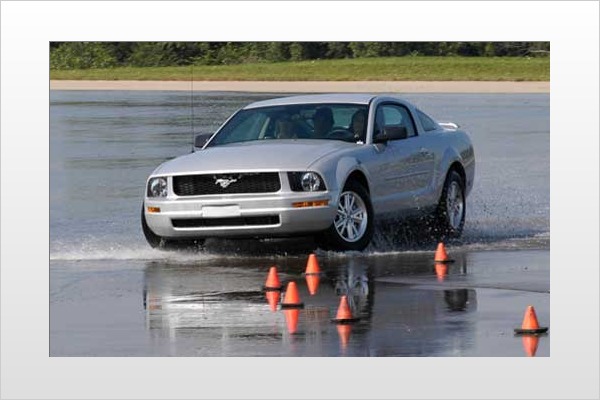
I'm sitting in the tiny backseat of a Ford Mustang that is wildly out of control. Slick pavement underneath, the car's tail slides around, and I'm now skidding backward, utterly unable to affect my final destination. Dread is the prominent emotion, followed by this rather unintentionally mean-spirited thought: "This woman is responsible for teaching her teen how to drive, and she can't control this car to save her life. We're all doomed."
Thankfully, the incident was provoked by a driving instructor on the grounds of Ford Motor Company's vehicle test center in Romeo, Michigan, a rural community about an hour north of Detroit. Appropriately for this exercise, we were on what engineers call a skid pad, one of many specific driving areas on this expansive 4000-acre vehicle testing facility. The aforementioned driver was coached into the skid by our driving coach, and after another four or five tries, she began to get the hang of provoking a slide and then controlling it.
Welcome to Driving Skills for Life, a free program sponsored by the Ford Motor Company Fund, a charitable arm of Ford Motor Company. The program's goal is to teach high-performance-driving skills to some 700 teens, not their parents. This is a good thing, as I observed (and instructors informally confirmed) that the teens catch on to the teaching much more quickly than their parents.
Is the training effective? The answers I got from the teens were overwhelmingly positive. "I didn't know it really took that long to stop a car," said one of the participants in a typical response. The teens were excited to be able to drive aggressively in evasive maneuvers. Most also admitted that their parents had not provided them with safe opportunities to test a car's limits or any kind of practice in making evasive maneuvers. The obvious benefits provided by Driving Skills for Life were not lost on the young drivers, one of whom was my 17-year-old daughter.
Instruction focuses on four areas: hazard recognition, speed management, vehicle handling and managing the space around the vehicle, plus a classroom training session. While the program ran approximately eight hours, students spend only minutes behind the steering wheel. The pure logistics of moving 300 people through the prescribed exercises severely limits the hands-on time.
"We realize that we can't completely transform drivers in a day," says Jon Adkins of the Governors Highway Safety Association of Michigan, another important partner in the program. "But we hope it will raise the awareness about teen driving safety, and of the program's Web site, a place that has lots of good information and exercises."
Having once acted as a high-performance-driving instructor, I asked the program's instructors whether they felt the program was effective. The consensus was that if students are willing to learn, they will take away valuable information. They also admitted that one day of training that nets a student less than 20 minutes of behind-the-wheel time can only improve skills so much. In order for teens to make significant gains, more time in the driver seat is needed, and ideally, the time should be spread out over several days or longer.
Experiences like that can be had at dedicated high-performance-driving schools, though these programs cost thousands of dollars. The advantage is that, through repetition, what you cover over the course of several days at one of these schools becomes second nature. This is critical, so that when you encounter a dangerous situation, your body reacts without thinking. It's all about muscle memory, a reality that comes into play during every physical activity, from playing golf to kneading bread dough. But the trouble is that most drivers never develop muscle memory for evasive maneuvers.
Driving back to Detroit from Romeo, several points became clear. First, traditional teen driver education is totally inadequate (apologies to all the gym teachers who sacrifice their summers to teach driver's ed). Second, hands-on driving programs such as Ford's, while laudable, hardly make a dent in the almost 6000 annual teen deaths caused by motor vehicle crashes — the leading cause of teen fatalities.
What Driving Skills for Life may change, especially because of its Web site, is the awareness levels of teens and parents. Instructors at the event encouraged parents to take a greater role in actively teaching their teens about driving more safely. The program's Web site even provides a parent's guide to help in this area.
For another interesting take on teen driving schools, see Defensive Driving for Teenagers.
Related articles:
How To Crashproof Your Teen Driver
Essential Facts About Graduated Driver Licenses (GDL)